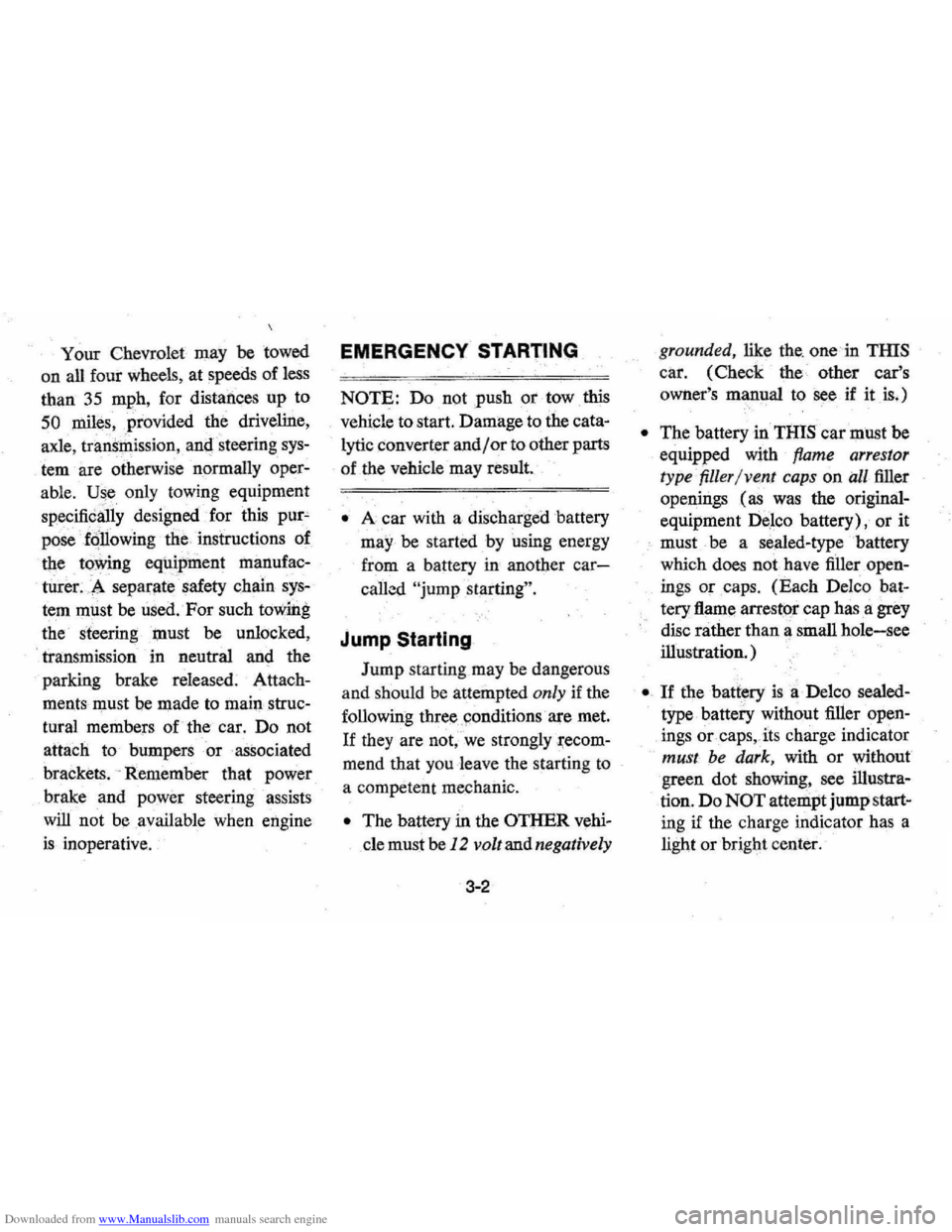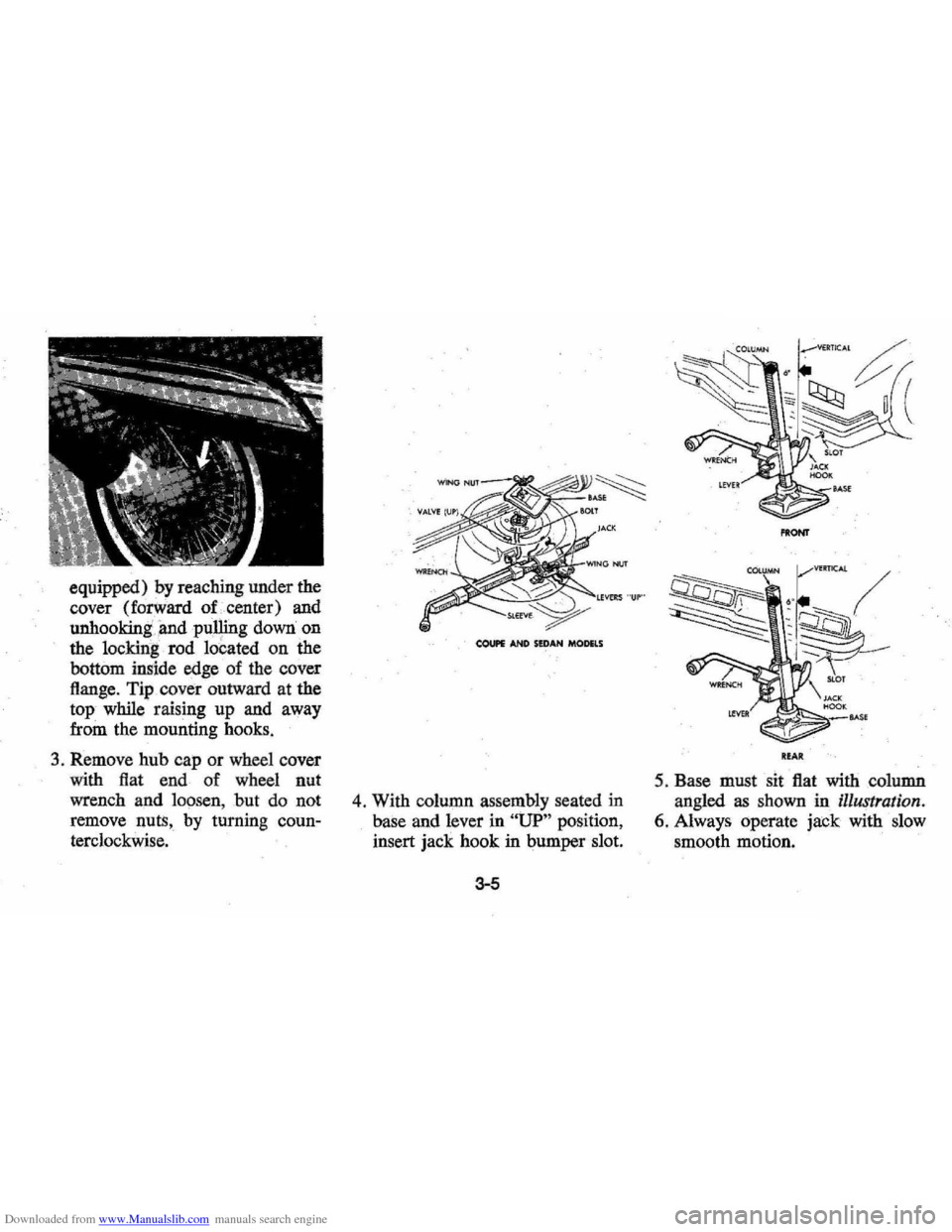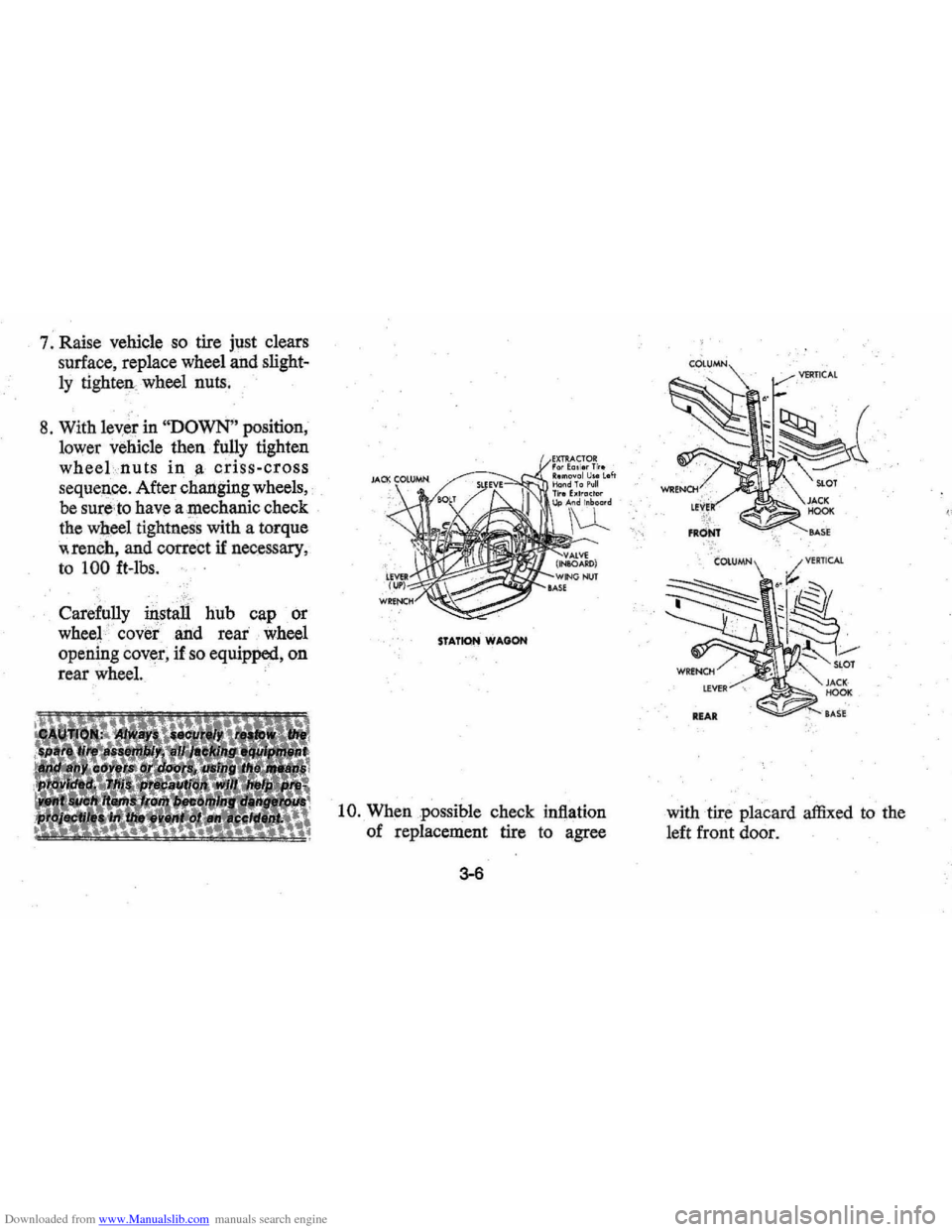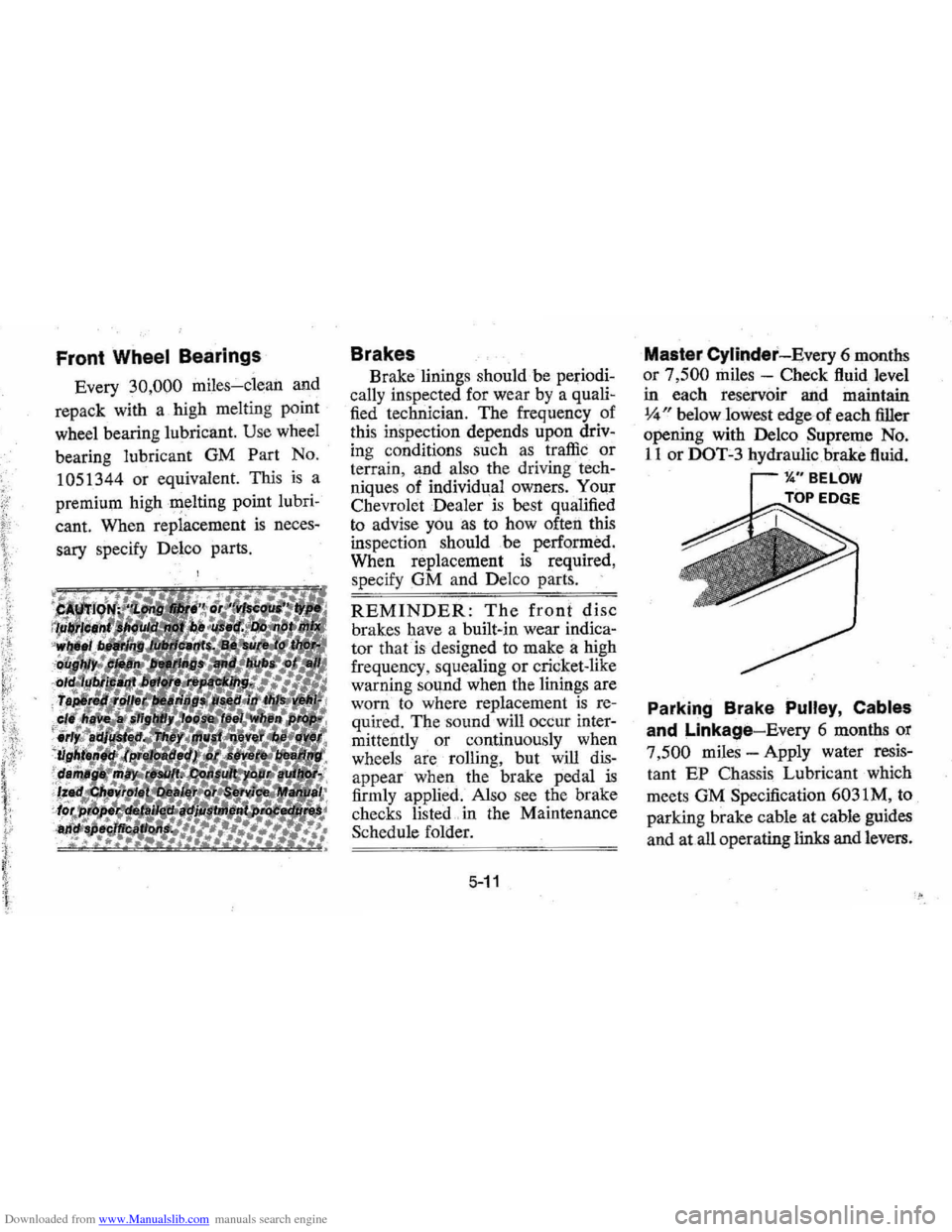1976 CHEVROLET MONTE CARLO wheel
[x] Cancel search: wheelPage 48 of 102

Downloaded from www.Manualslib.com manuals search engine l,nCase of Emergency '
Four Way Hazard
Warning Flasher
• Use the warningJlashe~ to warn
othe~ drivers allY time your ve
hicle becomes a traffic hazard,
day
ornight. ",
•
A void stopping on the roadway
if possible, .
.' Turn on the hazard warning
flasher
by pt\'shing in on the but,
ton located on the column just
below the steering
wheeL Flasher
can
be actuated with engine igni
tion either off
or on.
• Turn signals do not work with
hazard flashers operating.
• If the brake pedal is depfessed,
the lights will not flashbutre
main continuously lit
• To cancel the flasher, pull the
button out.
'':.',
Freeing Car From Sand; etc.
If it becomes 'neces sary to rock
the car to free it from sand, mud
or snow, move the selector lever
on automatic transmission models
from '~D" to "R" in a repeat pat
tern while simultaneously applying
moderate pressure to the accelera-
3-1
tor. Do not race engine. For best
possible traction, avoid spinning
wheels while
trying to free the car.
The use of AC Liquid Tire Chain
is recommended for temporary as
sistance when traction is lost on ice
or snow.
Towing
Proper lifting and towing equip
ment
is necessary to prevent dam
age to the vehicle during any
tow
ingoperation. State (Provincial in
Canada) and local
laws applicable
to vehicles in tow must be followed.
Detailed towing instructions are
available at your Chevrolet dealer.
Page 49 of 102

Downloaded from www.Manualslib.com manuals search engine Your Chevrolet may be towed
on all four wheels , at speeds of less
than
35 mph, for distances up to
50 miles, provided the driveline,
axle , tranSmission, and steering
sys
tem are otherwise normally oper
able.
Use only towing equipment
specifically designed for this
pur'
pose following the instructions of
the
towing equipment manufac
turer.A separllte safety chain sys
tem must be used. For such towing
the steeringi;Dust be unlocked,
' transmission in neutral
an~ the
parking brake released. Attach
ments must
oe made to mai!1 ,struc
tural members of the car. Do not
attach to bumpers or
,aSsociated
brackets. ' Remember that power
brake and power steering assists
will not be ,available when engine
is inoperative,
EMERGENCY STARTING
NOTE: Do not push or low this
vehicle to start. Damage to the cata
lytic converter and / or to other parts
of the vehicle may result.
• A car with a discharged 'battery
may be started by using energy
from a battery
in' another car
call<:!d "jump starting ".
Jump Starting
Jump starting may be dangerous
and should
be attempted only if the
followi!1g three , ,~onditions are met.
If they are not, we strongly,~ecom
mend that you leave the starting to
a competent mechanic.
• The battery in the OTHER vehi
cle must be
12 volt and negatively
3-2
grounded, like the, one in TillS
car. (Check the' other car's
owner's manual
to see if it is.)
• The battery in THIS car must be
equipped with
flame arrestor
type
filler / venl caps on all filler
openings (as
was the original
equipment
De ,lco battery), or it
, must be a sealed-type battery
which does not have
fi'tler open
ings or
caps, (Each Delco bat
tery flame arrestor cap has a grey
disc rather than a small hole-see
illustration. )
•. If thebatiery is a Delco sealed
type battery without filler open
ings or
caps"its charge indicator
must be dark, with or without
green dot showing, see illustra
tion. Do
NOT attempt jump start
ing
if the charge indicator has a
light or bright center.
Page 51 of 102

Downloaded from www.Manualslib.com manuals search engine 4. Attach the remaining jumper
cable
FIRST to the negative
terminal (black color,
"-", or)
"N") of the OTHER vehicle's
battery,
'. (regardless of which
vehicl~ 'has the dis!:harged bat
tery)
and THEN to the negative
tertniDal of the battery in TIllS
car-thus taking advantage of
the
J\ame arrestor feature on the
bat~ in TIllS car, should a
. spark occur .
5. St~the engine in the vehicle
that. is providing the jump start
(iOt was not running). Let run
a
few minutes , then start the en
gin~ in the car that has the dis
charged battery.
6. Reverse the above sequence
EXACTLY when removing the
jumper cables, taking care
to
remove the cable from the nega
tive terminal of the battery
in
THIS
car as the FIRSI' step.
Engine Coolant
'.,"
3-4
JACKING INSTRUCTIONS
Preparation
• Park on level surface and set
parkir)g brake firmly.
• Set automatic ,transmission in
park.
• Activatehazard",vaming flasher.
Instructions
1. After removing spare wheel and
tire, jack, jack
base, and jack
handle (wheel nut wrench), pro
ceed with changing the wheel
as follows: '
2 . When removing rear wheel,
re
move wheel opening cover (if so
Page 52 of 102

Downloaded from www.Manualslib.com manuals search engine equipped) by reaching under the
cover (forward
of. center) and
unhooking :and pulling down on
the
locking rod loeated on the
bottom inside edge of the cover
flange. Tip cover outward at the
top while raising up and away
from the mounting hooks.
3 . Remove hub cap or wheel cover
with flat end
of wheel nut
wrench and loosen , but do not
remove
nutS, by turning coun
terclockwise.
COUPE AND S£DAH MODElS
4 . With column assembly seated in
base and lever in
"UP" position,
insert jack hook in bumper slot.
3-5
PltONT
ItfA"
5. Base must sit flat with column
angled
as shown in illustration.
6. Always operate jack with slow
smooth motion.
Page 53 of 102

Downloaded from www.Manualslib.com manuals search engine 7. Raise vehicle so tire just clears
surface, replace wheel and
slight
ly tighteawheel nuts.
8. With leyer in "DOWN" position,
lower vehicle then fully tighten
wheeLnuts in a criss-cross
seq ueIice. After chariging wheels,
be sure,to have a mechanic check
the wheel tightness with a torque
"rench, and correct if necessary ,
to 100 ft-lbs.
Carefully instali hub cap or
wheel '
covet and rear.' wheel
opening cover, if
so equipped, on
rear wheel.
.
STATION WAGON
10. When possible check inflation
of replacement tire
to a,gree
3-6
with tire placard affixed to the
left front door.
Page 72 of 102

Downloaded from www.Manualslib.com manuals search engine Front Wheel Bearings
Every 30,000 miles-clean and
repack with
a. high melting point
wheel bearing lubricant.
Use wheel
bearing lubricant GM Part No.
1051344 or equivalent. This
is a
premium high
~elting point lubri
cant. When replacement is neces
sary specify Delco parts.
Brakes
Brake linings should be periodi
cally inspected for wear
by a quali
fied technician. The frequency of
this inspection depends upon
driv
ing conditions such as traffic or
terrain, and also the driving tech
niques of individual owners .. Your
Chevrolet Dealer is best qualified
to advise you
as to how often this
inspection should be performed.
When replacement is required,
specify
GM and Delco parts.
REMINDER: The front disc
brakes have a built-in wear indica
tor
thatis designed to make a high
frequency , squealing
or cricket-like
warning
sOl!l1d when the linings are
worn to where replacement is re
quired. The sound will occur inter
mittently or continuously when
wheels are rolling, but will
dis
appear when the brake pedal is
firmly applied. Also see the brake
checks listed. in the Maintenance
Schedule folder.
5-11
Master Cylinder-Every 6 months
or
7,500 miles -Check fluid level
in each reservoir and maintain
14" below lowest edge-of each filler
opening with Delco Supreme No.
liar DOT-3 hydraulic brake fluid.
11." BELOW
TOP EDGE .k:::O"',
Parking Brake Pulley, Cables
and Linkage-Every 6 months or
7
,500 miles -Apply water resis
tant EP Chassis Lubricant which
meets GM Specification 6031M, to
parking brake cahle at cable guides
and at all operating links and levers.
Page 78 of 102

Downloaded from www.Manualslib.com manuals search engine LF RF LF
LR RR RR
.5 WHEEl ROTATION .. ··WHEEl ROTATION
RADIAL TIRES
BIAS PLY TIRE BIAS PLY TIRE .. WHEEl ROTATION .5 WHEEl ROTAtiON
BIAS-BELTED TIRES
driving habits, etc. To obtain maxi
mum. tire life you should inspect
a nd rotate your tires regularly.
Many car .and tire dealers will per
form a free tire inspection and
assist you in identifying uneven
or abnormal tire
wear which is
usually the result of incorrect infla
tion pressure , lack of regular rota
tion, improper wheel alignment,
out-of-balance ,
or poor driving
habits.
Bias and bias-belted tires should
be rotated
at least every 7,500
miles . Radial tires should be ro
tated at least at the first 7,500 miles
and then
at least at 15,000 mile in
tervals thereafter .or whenever. un
even tire wear is noticed.
Alignment and Balance
Proper front-end alignment ~i~i
mizes tire tread wear: To mlmmlze
tire wear, your front-end
susp~n
sion components should be m-
5-17
NOTE: It is recommended that the
brake s be
inspected for wear when
ever the tires are rotated.
spected regularly. See the
Main:e
nance Schedule folder for more lU
formation. Some ball-joints have
built-in wear indicators and some
movement in the joints
is normal.
Improper front -end alignment will
not cause vibration. Improper to e
alignment may cause your front.
tires to drag at an angle resulting in
excessive wear. Improper camber
alignment
may cause your front
tires to wear more on one side than
on the other arid can cau se the
vehicle to
"pull" to the left or right.
Proper tire balancing provides
the best riding comfort and helps
to minimiz e tire tread wear.
Out-of
balance tires can cause annoyin g
vehicle vibration and irregular tire
wear such
as cupping, flat spots,
etc.
Page 81 of 102

Downloaded from www.Manualslib.com manuals search engine belted, or radial) as originally in
stalled on your vehicle . Use of any
other size or type tire
may seriously
affect
ride , handling , speedometer /
odometer~ calibration, vehicle
ground
9learance, and~ tire clear
ance to the body and chassis.
On .' most vehicles . originally
equipp~d with radial tires, you will
find a'TPC Spec. : No. (Tire Per,
formarlce
Criteria Specificati?n
size
TPC SlIC.NO.
LOAD lANGe
BRAND NAME -----'CONSTRUCTION EXAMPLE TIRE
SIU ,OADIANGI (OMITI\lCT 'ON TI'<:SI'K..NO .
-~~,._u ~. .$ •• .,1 . " ' .. ~ lad ... .100'
Number) molded into the tire side
wall adjacent to the~tire size mark
ing. This designation indicates that
the tire meets rigid dimensional and
performance standards which were
developed for your
~ cil-r. These
specifi,cations insure
a. proper bal
ance of: enduranc~, handling,
noise, ride, road hazard resistance,
rolling resistance; traction,
and'
tread
mileage, ReplaciQg your tires
with tires having the sameTPC Spec.
No.
will assure yqu that your new
tires
~re compatable with your car.
Wheel Replacement
Considerations
Wheels must be replaced if bent,
heavily rusted, leak
air, or if lug
nuts continually loosen. Do not
straighten bent wheels or
use inner
tu bes in leaking wheels.
When replacing
Wheels for any
reason, the replacement wheels
should be equivalent in load
capa-
5-20
city, diameter; width, offset, and
mounting configurations to those
~ originally installed on your vehicle.
Replacement wheels can
be ob
tained from your
CheVrolet dealers.
A wheel of improper
size or type
may .
adversel'y affect wheel and
bearing life, brake
cooling, speed
ometer/odometer calibration, ~ ve
hicle ground dearance, and tire
clearance to
thibody and chassis.
Replacement
with "used" wheels
which may have been subjected to
harsh operating cQnditions or very
high mileage
is n@t recommended.
These wheels may fail prematurely
without
any , prior 0sual indication.
Warranty
Tires . are guarante~d by the tire
manufacturers.
Guar/lntee informa
tion is included in the Passenger
Car Tire Owner's Guaranteefolder
furnished with your vehicle.